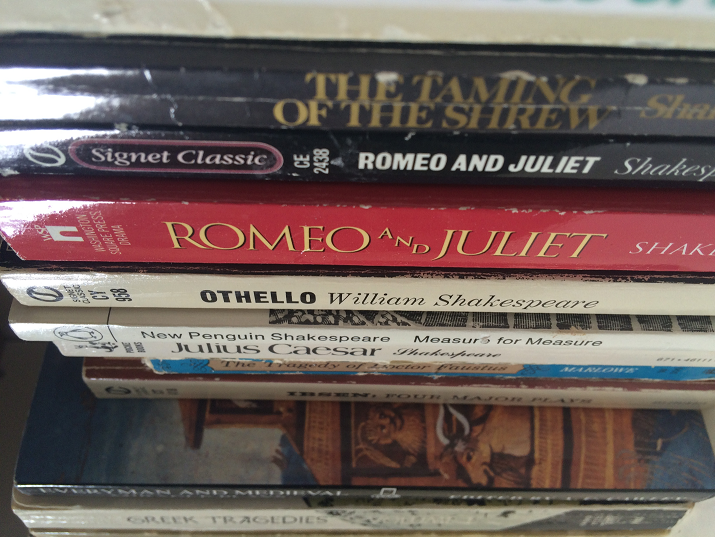What Books to Read Before AP English classes?
In the dreaded spectrum of AP classes, students always feel that there is more that they can do to increase their scores. For some, they just do the homework and rely on innate intelligence, but for the rest of us looking over study guides, going through notes, and watching lessons on YouTube fill the hours up to the day of the test. So for some extra help that can be found far before the AP tests, here are a few books that would be extremely helpful before taking the AP English classes and their exams.
AP English Language, usually taken by juniors, is a class about nonfiction literature (it’s a goldmine for forensics kids). Along with reading many speeches and articles, the students learn how to analyze and understand nonfiction literature.
Mrs. Morgan, one of the AP Lang. teachers, recommended two books. She also said that the real thing that students in AP Lang. should do is keep up on current events. This is easier than ever now with smart phones and news apps updating and popping up notifications 24/7.
Animal Farm by George Orwell (1945)
Read most of the time in freshman lit classes, Animal Farm is usually the first allegory students encounter. Animal Farm is an allegory for the history of Soviet communism told through farm animals. This anti-totalitarian novel is not a hard read but should be carefully read so as to get the full effect of the allegory.
1984 by George Orwell (1949)
Another one of Orwell’s classic, this dystopian novel is slightly harder than Animal Farm. It attacks totalitarian communism by creating a world where personal freedoms no longer exist. The book centers around Winston Smith, who works for the ruling Party in London. He is watched by the Party everywhere he goes and everywhere he looks he sees the leader of the Party, Big Brother.
AP English Literature is usually taken by seniors. This class deals with fiction literature. In AP Lit., students read poems and prose and learn how to pick them apart to reveal diction, syntax, and imagery. Seniors have to read many more books in this class than in AP Lang. (Be prepared for a heavier work load).
Ms. Austgen just kept on coming up with books that students should read not just for the AP test but also for life. As she always says the best way to get a better vocabulary is to read.
Invisible Man by Ralph Ellison (1952)
Claimed to be the most important American novel to appear after World War II, Invisible Man deals with the experience of being black in America. Ellison, an African American living in the time of civil rights, uses the French writer’s idea of existentialism to show the oppression and prejudice against African Americans.
The Road by Cormac McCarthy (2006)
The Road is an incredibly moving book. It takes place in a post-apocalyptic world. McCarthy uses an unnamed pair, a father and his son, to tell the story of life after the apocalypse. Death and violence are central themes as humans revert to horrific behaviors in the face of disaster (murder, rape, and cannibalism). A book in which every action is accounted into life and death, the book won the 2007 Pulitzer Prize and was turned into a movie.
Lord of the Flies by William Golding (1954)
Another dystopian novel, this novel is easy to read and is read in freshman lit. It’s about a group of British boys whose plane crashes on a deserted island. The plot line is them trying to govern themselves. The concepts of human nature as beastly like the philosopher Hobbes said. Fun fact: Lord of the Flies is a reaction to the youth novel The Coral Island.
Brave New World by Aldous Huxley (1932)
Brave New World is set in 2540 AD. Aldous Huxley, Who originally wrote satires, moved to a more philosophical genre focusing on the conflict of interests between society and the individual. It is another dystopian society in which a totalitarian government controls everything. An easy read and a bit monotonous in the middle but it sets the stage beautifully for the action packed ending.
Pride and Prejudice by Jane Austen (1813)
A classic which everyone should read, Jane Austen’s Pride and Prejudice follows young Elizabeth Bennett and her sisters in their quests for husbands. A charming novel that is pretty long, Pride and Prejudice deals with the themes of class, wealth, and women in the 17th century. Many adaptations have come around from its original brilliance including Pride and Prejudice and Zombies and several movies based on the original.

Cloud Atlas by David Mitchell (2004)
Cloud Atlas has a very distinctive organization. It’s writer, David Mitchell, created six separate stories spanning the globe and about a thousand years. Mitchell excels at writing complicated literature. The book is never boring as once the plot gets exciting it changes to another story.
Cry, the Beloved Country by Alan Paton (1948)
Cry the Beloved Country, written by South African author Alan Paton, is about a black Anglican priest, Stephen Kumalo, who goes to search for his son in Johannesburg. The book centralizes around the social instability and moral issues due to the breakdown of the tribal system in Africa. It also deals with the racism in Africa.
Beloved by Toni Morrison (1987)
Inspired by the story of an African American slave, Margaret Garner, who escaped slavery, Beloved is a story about Sethe, a slave who escapes with her daughter to Ohio from Kentucky. Her story is extremely moving. Morrison’s story borders between fiction and history to look at the psychological and historical legacy of slavery.
The Great Gatsby by F. Scott Fitzgerald (1925)
Read typically in junior year as a part of summer reading, Fitzgerald was one of the most writers that documented the 1920s. The Great Gatsby is one of the greatest literary documents of “the Jazz Age”. This novel itself has its own story. It sold badly and Fitzgerald died thinking, he was a failure. But the book had a revival during World War II and now it is one of the most American books out there.
The Alchemist by Paulo Coelho (1988)
The Alchemist is an allegorical novel which follows a comfortable shepherd who decides to leave everything to pursue his dream. The main character Santiago has a dream that that he will find a hidden treasure if he travels to the Egyptian pyramids. Santiago is connected to Coelho’s own life through their setbacks and actions.

Bonjourno! Me llamo Sophie. I am a tri(sort of) lingual senior with a large passion for sarcasm and baked goods. I still am in band, writers guild, link...



